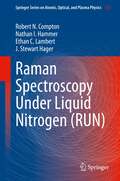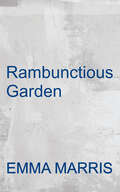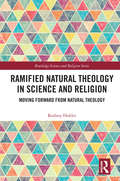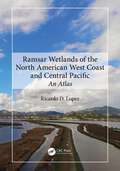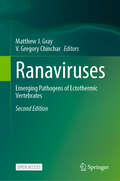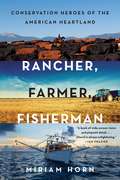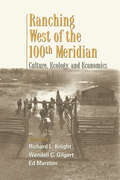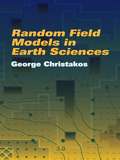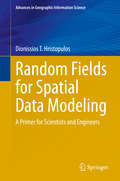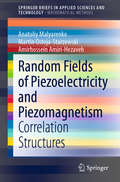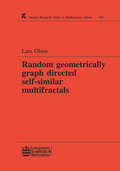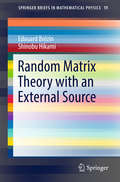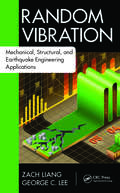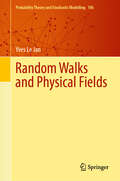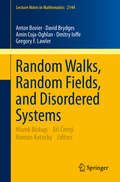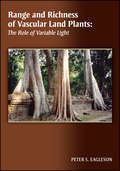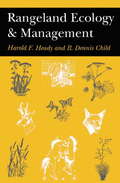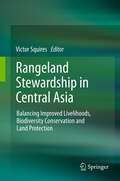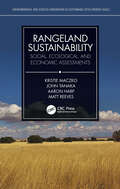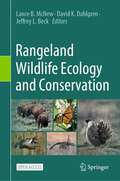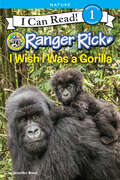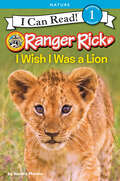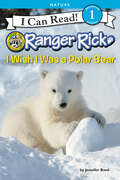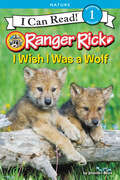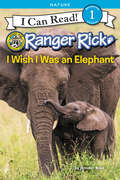- Table View
- List View
Raman Spectroscopy Under Liquid Nitrogen (Springer Series on Atomic, Optical, and Plasma Physics #121)
by Robert N. Compton Nathan I. Hammer Ethan C. Lambert J. Stewart HagerThis book describes a simple yet innovative method for performing Raman spectroscopy of samples submerged under liquid nitrogen. While Raman spectroscopy has proven to be a powerful tool for the characterization of the structure of matter in the gaseous, liquid, and solid phases, one major difficulty in its application has been laser damage to the material under investigation, especially for biological samples. This book demonstrates how immersion of the sample in liquid nitrogen protects the sample from thermal degradation and oxidation at high incident laser power and allows improvements in sensitivity and spectral resolution over room-temperature Raman spectroscopy, leading to the so-called RUN (Raman Spectroscopy Under liquid Nitrogen) technique. Cooling to liquid nitrogen temperature also allows the selection of the lowest energy molecular conformation for molecules which may have many low energy conformers. In addition, the presence of liquid nitrogen over a roughened surface improves the sensitivity of Surface Enhanced Raman Spectroscopy (SERS), enabling the closely related SERSUN (Surface-Enhanced Raman Spectroscopy Under liquid Nitrogen) technique. This book starts with the theoretical and experimental basics of Raman and polarized Raman spectroscopy, before moving on to detailed descriptions of RUN and SERSUN. Room temperature and RUN spectra are provided for over fifty molecules.
Rambunctious Garden: Saving Nature in a Post-Wild World
by Emma MarrisA paradigm shift is roiling the environmental world. For decades people have unquestioningly accepted the idea that our goal is to preserve nature in its pristine, pre-human state. But many scientists have come to see this as an outdated dream that thwarts bold new plans to save the environment and prevents us from having a fuller relationship with nature. Humans have changed the landscapes they inhabit since prehistory, and climate change means even the remotest places now bear the fingerprints of humanity. Emma Marris argues convincingly that it is time to look forward and create the "rambunctious garden," a hybrid of wild nature and human management.
Ramified Natural Theology in Science and Religion: Moving Forward from Natural Theology (Routledge Science and Religion Series)
by Rodney HolderThis book offers a rationale for a new ‘ramified natural theology’ that is in dialogue with both science and historical-critical study of the Bible. Traditionally, knowledge of God has been seen to come from two sources, nature and revelation. However, a rigid separation between these sources cannot be maintained, since what purports to be revelation cannot be accepted without qualification: rational argument is needed to infer both the existence of God from nature and the particular truth claims of the Christian faith from the Bible. Hence the distinction between ‘bare natural theology’ and ‘ramified natural theology.’ The book begins with bare natural theology as background to its main focus on ramified natural theology. Bayesian confirmation theory is utilised to evaluate competing hypotheses in both cases, in a similar manner to that by which competing hypotheses in science can be evaluated on the basis of empirical data. In this way a case is built up for the rationality of a Christian theist worldview. Addressing issues of science, theology and revelation in a new framework, this book will be of keen interest to scholars working in Religion and Science, Natural Theology, Philosophy of Religion, Biblical Studies, Systematic Theology, and Science and Culture.
Ramsar Wetlands of the North American West Coast and Central Pacific: An Atlas
by Ricardo D. LopezThis is the first comprehensive international atlas featuring all ecological services provided by Ramsar wetlands, with complete views of all Ramsar sites, through remote sensing and mapping. Written by an international expert on wetlands and remote sensing, this atlas is for a broad audience and compiles much-needed information on how the Ramsar wetlands are of significant value to the planet and society and can and should be managed in such a way that supports planetary sustainability. Focused on the 72 designated Ramsar sites along the western coasts of Alaska, Canada, California, Mexico, and the Central Pacific islands, each wetland is articulately documented with respect to its specific ecological functions and services.FEATURES Provides a comprehensive assessment of the key biophysical and societal elements of each Ramsar-designated wetland along the North American West Coast and Central Pacific Brings all designated Ramsar wetlands to the reader in one visually appealing compendium using geospatial technology Aids in highlighting the importance of and options for wetland conservation and restoration worldwide Explains the important role that wetlands play in environmental sustainability, directly supporting the global sustainable development goals of the United Nations Introduces the contributions of the Ramsar Convention on Wetlands to global conservation and restoration This atlas is intended for wetland managers and policymakers involved in the Ramsar Convention activities and for wetland ecologists and other allied environmental scientists and practitioners, such as hydrologists, microbiologists, and botanists. It is also a valuable resource for researchers, faculty, and graduate students affiliated with programs such as wetland ecology, wetland management, environmental studies, environmental management, and survey of wetlands.
Ranaviruses: Emerging Pathogens of Ectothermic Vertebrates
by Matthew J. Gray V. Gregory ChincharThis is a open access book. Ranaviruses, double-stranded DNA viruses (family Iridoviridae) that cause systemic, life-threatening disease in a variety of amphibians, reptiles and fish, have contributed to mass die-offs of both wild and captive populations around the globe. These viruses are emerging and increasingly responsible for population declines of ectothermic vertebrates. Because amphibians, reptiles, and freshwater turtles are suitable hosts and among the most imperiled vertebrate taxa in the world, ranaviruses can have significant impacts on biodiversity and ecosystem function. Additionally, many fish that are raised in aquaculture facilities and traded internationally are suitable hosts; thus, the potential economic impact of ranaviruses is significant. Ranaviruses also serve as a model for understanding viral replication and gene function among large double-stranded DNA viruses, e.g., poxviruses, asfarvirus, and ascoviruses. Lastly, study of the host immune response to ranaviral disease and the identification of viral immune evasion genes that negatively regulate host immune functions provide insight into which specific immune elements are most important in protecting host species against severe disease. The effort to produce a 2nd edition of our earlier work grew out of a recent meeting (1st Global Amphibian and Reptile Disease Conference) held in August 2022. Given the continued research in ranaviruses and ranaviral disease since the first edition, this new book updates the latest information on ranaviruses and provides guidance on how to monitor and manage ranaviruses in cold-blooded vertebrate populations.
Rancher, Farmer, Fisherman: Conservation Heroes of the American Heartland
by Miriam HornThe story of a huge, largely hidden, and entirely unexpected conservation movement in America. Many of the men and women doing today's most consequential environmental work--restoring America's grasslands, wildlife, soil, rivers, wetlands, and oceans--would not call themselves environmentalists; they would be too uneasy with the connotations of that word. What drives them is their deep love of the land: the iconic terrain where explorers and cowboys, pioneers and riverboat captains forged the American identity. They feel a moral responsibility to preserve this heritage and natural wealth, to ensure that their families and communities will continue to thrive. Unfolding as a journey down the Mississippi River, Rancher, Farmer, Fisherman tells the stories of five representatives of this stewardship movement: a Montana rancher, a Kansas farmer, a Mississippi riverman, a Louisiana shrimper, and a Gulf fisherman. In exploring their work and family histories and the essential geographies they protect, Rancher, Farmer, Fisherman challenges pervasive and powerful myths about American and environmental values.
Ranching West of the 100th Meridian: Culture, Ecology, and Economics
by Richard L. Knight Ed Marston Wendell GilgertRecommended by The Nature Conservancy magazine.Ranching West of the 100th Meridian offers a literary and thought-provoking look at ranching and its role in the changing West. The book's lyrical and deeply felt narratives, combined with fresh information and analysis, offer a poignant and enlightening consideration of ranchers' ecological commitments to the land, their cultural commitments to American society, and the economic role ranching plays in sustainable food production and the protection of biodiversity.The book begins with writings that bring to life the culture of ranching, including the fading reality of families living and working together on their land generation after generation. The middle section offers an understanding of the ecology of ranching, from issues of overgrazing and watershed damage to the concept that grazing animals can actually help restore degraded land. The final section addresses the economics of ranching in the face of declining commodity prices and rising land values brought by the increasing suburbanization of the West. Among the contributors are Paul Starrs, Linda Hasselstrom, Bob Budd, Drummond Hadley, Mark Brunson, Wayne Elmore, Allan Savory, Luther Propst, and Bill Weeks.Livestock ranching in the West has been attacked from all sides -- by environmentalists who see cattle as a scourge upon the land, by fiscal conservatives who consider the leasing of grazing rights to be a massive federal handout program, and by developers who covet intact ranches for subdivisions and shopping centers. The authors acknowledge that, if done wrong, ranching clearly has the capacity to hurt the land. But if done right, it has the power to restore ecological integrity to Western lands that have been too-long neglected. Ranching West of the 100th Meridian makes a unique and impassioned contribution to the ongoing debate on the future of the New West.
Random Field Models in Earth Sciences
by George ChristakosThis graduate-level text explores problems in earth sciences in which the random field model constitutes an effective approach. A critical and concise summary of the fundamental concepts and results of the general random field theory is followed by considerations of the intrinsic spatial random field model, and more. 103 figures. 16 tables.
Random Fields for Spatial Data Modeling: A Primer for Scientists and Engineers (Advances in Geographic Information Science)
by Dionissios T. HristopulosThis book provides an inter-disciplinary introduction to the theory of random fields and its applications. Spatial models and spatial data analysis are integral parts of many scientific and engineering disciplines. Random fields provide a general theoretical framework for the development of spatial models and their applications in data analysis. The contents of the book include topics from classical statistics and random field theory (regression models, Gaussian random fields, stationarity, correlation functions) spatial statistics (variogram estimation, model inference, kriging-based prediction) and statistical physics (fractals, Ising model, simulated annealing, maximum entropy, functional integral representations, perturbation and variational methods). The book also explores links between random fields, Gaussian processes and neural networks used in machine learning. Connections with applied mathematics are highlighted by means of models based on stochastic partial differential equations. An interlude on autoregressive time series provides useful lower-dimensional analogies and a connection with the classical linear harmonic oscillator. Other chapters focus on non-Gaussian random fields and stochastic simulation methods. The book also presents results based on the author’s research on Spartan random fields that were inspired by statistical field theories originating in physics. The equivalence of the one-dimensional Spartan random field model with the classical, linear, damped harmonic oscillator driven by white noise is highlighted. Ideas with potentially significant computational gains for the processing of big spatial data are presented and discussed. The final chapter concludes with a description of the Karhunen-Loève expansion of the Spartan model. The book will appeal to engineers, physicists, and geoscientists whose research involves spatial models or spatial data analysis. Anyone with background in probability and statistics can read at least parts of the book. Some chapters will be easier to understand by readers familiar with differential equations and Fourier transforms.
Random Fields of Piezoelectricity and Piezomagnetism: Correlation Structures (SpringerBriefs in Applied Sciences and Technology)
by Anatoliy Malyarenko Martin Ostoja-Starzewski Amirhossein Amiri-HezavehRandom fields are a necessity when formulating stochastic continuum theories. In this book, a theory of random piezoelectric and piezomagnetic materials is developed. First, elements of the continuum mechanics of electromagnetic solids are presented. Then the relevant linear governing equations are introduced, written in terms of either a displacement approach or a stress approach, along with linear variational principles. On this basis, a statistical description of second-order (statistically) homogeneous and isotropic rank-3 tensor-valued random fields is given. With a group-theoretic foundation, correlation functions and their spectral counterparts are obtained in terms of stochastic integrals with respect to certain random measures for the fields that belong to orthotropic, tetragonal, and cubic crystal systems. The target audience will primarily comprise researchers and graduate students in theoretical mechanics, statistical physics, and probability.
Random Geometrically Graph Directed Self-Similar Multifractals (Chapman And Hall/crc Research Notes In Mathematics Ser. #307)
by Lars OlsenMultifractal theory was introduced by theoretical physicists in 1986. Since then, multifractals have increasingly been studied by mathematicians. This new work presents the latest research on random results on random multifractals and the physical thermodynamical interpretation of these results. As the amount of work in this area increases, Lars Olsen presents a unifying approach to current multifractal theory. Featuring high quality, original research material, this important new book fills a gap in the current literature available, providing a rigorous mathematical treatment of multifractal measures.
Random Matrix Theory with an External Source
by Edouard Brézin Shinobu HikamiThis is a first book to show that the theory of the Gaussian random matrix is essential to understand the universal correlations with random fluctuations and to demonstrate that it is useful to evaluate topological universal quantities. We consider Gaussian random matrix models in the presence of a deterministic matrix source. In such models the correlation functions are known exactly for an arbitrary source and for any size of the matrices. The freedom given by the external source allows for various tunings to different classes of universality. The main interest is to use this freedom to compute various topological invariants for surfaces such as the intersection numbers for curves drawn on a surface of given genus with marked points, Euler characteristics, and the Gromov-Witten invariants. A remarkable duality for the average of characteristic polynomials is essential for obtaining such topological invariants. The analysis is extended to nonorientable surfaces and to surfaces with boundaries.
Random Vibration: Mechanical, Structural, and Earthquake Engineering Applications (Advances in Earthquake Engineering)
by Zach Liang George C. LeeFocuses on the Basic Methodologies Needed to Handle Random ProcessesAfter determining that most textbooks on random vibrations are mathematically intensive and often too difficult for students to fully digest in a single course, the authors of Random Vibration: Mechanical, Structural, and Earthquake Engineering Applications decided to revise the cu
Random Walks and Physical Fields (Probability Theory and Stochastic Modelling #106)
by Yves Le JanThis book presents fundamental relations between random walks on graphs and field theories of mathematical physics. Such relations have been explored for several decades and remain a rapidly developing research area in probability theory.The main objects of study include Markov loops, spanning forests, random holonomies, and covers, and the purpose of the book is to investigate their relations to Bose fields, Fermi fields, and gauge fields. The book starts with a review of some basic notions of Markovian potential theory in the simple context of a finite or countable graph, followed by several chapters dedicated to the study of loop ensembles and related statistical physical models. Then, spanning trees and Fermi fields are introduced and related to loop ensembles. Next, the focus turns to topological properties of loops and graphs, with the introduction of connections on a graph, loop holonomies, and Yang–Mills measure. Among the main results presented is an intertwining relation between merge-and-split generators on loop ensembles and Casimir operators on connections, and the key reflection positivity property for the fields under consideration.Aimed at researchers and graduate students in probability and mathematical physics, this concise monograph is essentially self-contained. Familiarity with basic notions of probability, Poisson point processes, and discrete Markov chains are assumed of the reader.
Random Walks, Random Fields, and Disordered Systems
by Anton Bovier David Brydges Amin Coja-Oghlan Dmitry Ioffe Gregory F. LawlerMarek Biskup Jiří Černý Roman KoteckýFocusing on the mathematics that lies at the intersection of probability theory, statistical physics, combinatorics and computer science, this volume collects together lecture notes on recent developments in the area. The common ground of these subjects is perhaps best described by the three terms in the title: Random Walks, Random Fields and Disordered Systems. The specific topics covered include a study of Branching Brownian Motion from the perspective of disordered (spin-glass) systems, a detailed analysis of weakly self-avoiding random walks in four spatial dimensions via methods of field theory and the renormalization group, a study of phase transitions in disordered discrete structures using a rigorous version of the cavity method, a survey of recent work on interacting polymers in the ballisticity regime and, finally, a treatise on two-dimensional loop-soup models and their connection to conformally invariant systems and the Gaussian Free Field. The notes are aimed at early graduate students with a modest background in probability and mathematical physics, although they could also be enjoyed by seasoned researchers interested in learning about recent advances in the above fields.
Range and Richness of Vascular Land Plants: The Role of Variable Light (Special Publications #61)
by Peter S. EaglesonPublished by the American Geophysical Union as part of the Special Publications Series. This is a research monograph and not a textbook. Here I demonstrate analytically how the observed, opposing, latitudinal gradients in the average range and richness of local vascular land plant species are (outside the moist-tropical zone, at least) driven primarily by the local temporal and spatial variability of shortwave radiative flux at the canopy top. (The term "richness" as used here means the local number of different vascular land plant species unlimited by the size of the area sampled.) The hypotheses are simplistic but are nevertheless convincingly accurate in extratropical latitudes when tested against observations over the continental land surfaces of the Northern Hemisphere, the only areas tested here.
Rangeland Ecology And Management
by Harold Heady R. Dennis ChildOver the last two decades the science of range management, like many other resource disciplines, has embraced and integrated environmental concerns in the field, the laboratory, and policy. Rangeland Ecology and Management now brings this integrated approach to the classroom in a thoroughly researched, comprehensive, and readable text. The authors discuss the basics of rangeland management--including grazing and practical management of animals and vegetation--and place those basics within the context of decision making for damaged land, riparian and water conservation, multiple use, and modeling. Concepts such as succession, stability, and range condition are examined and their effects discussed. Fire is considered as an environmental factor. Appendixes provide scientific and common names of range plants and animals. These and many other issues crucial to the understanding of successful range management combine to make the finest text for upper-level undergraduates now available.
Rangeland Stewardship in Central Asia
by Victor R. SquiresThis volume of 18 chapters is the work of more than 30 authors, many of whom are natives of the Central Asian region or are researchers who have dedicated a large part of their working lives to studying the development dynamics in this vast and fascinating region. The work focuses on the 20 years since the collapse of the Soviet Union in 1990. But it also traces the attitudes of land users to the land dating from before the late 19th century, when Russian conquest and colonization occurred, and through the upheavals caused by Soviet-style collectivization and sedentarization. The book is rich with new data presented in 68 easy to understand charts/graphs (many in color) and 50 Tables. Information was generated for this book by experts working in-country. It presents for the first time in English a digest of plethora of previously inaccessible Russian reports and scientific literature that will be invaluable for development agencies, including UN, World Bank, Asian Development Bank, Islamic Bank as well as to students of this vast and fascinating region who seek up to date and authoritive information.
Rangeland Sustainability: Social, Ecological, and Economic Assessments (Environmental and Societal Dimensions of Sustainable Development Goals)
by Kristie Maczko Aaron Harp John Tanaka Matt ReevesThis book provides an integrated description of the indicators of rangeland sustainability that capture ecological, economic, and social dimensions. It takes a fresh look at the information available on current and emerging issues across rangelands, and presents collaborative research for future progress. Authors offer a framework for evaluating rangeland sustainability, the best available data to use, as well as an interactive tool for use at a variety of geographical scales. Readers with limited knowledge of rangelands, as well as professional rangeland ecologists and land managers, will gain an understanding of the best tools available today to assess sustainability across rangeland ecosystems in the U.S.
Rangeland Wildlife Ecology and Conservation
by Lance B. McNew David K. Dahlgren Jeffrey L. BeckThis open access book reviews the importance of ecological functioning within rangelands considering the complex inter-relationships of production agriculture, ecosystem services, biodiversity, and wildlife habitat. More than half of all lands worldwide, and up to 70% of the western USA, are classified as rangelands—uncultivated lands that often support grazing by domestic livestock. The rangelands of North America provide a vast array of goods and services, including significant economic benefit to local communities, while providing critical habitat for hundreds of species of fish and wildlife. This book provides compendium of recent data and synthesis from more than 100 experts in wildlife and rangeland ecology in Western North America. It provides a current and in-depth synthesis of knowledge related to wildlife ecology in rangeland ecosystems, and the tools used to manage them, to serve current and future wildlife biologists and rangeland managers in the working landscapes of the West. The book also identifies information gaps and serves as a jumping-off point for future research of wildlife in rangeland ecosystems. While the content focuses on wildlife ecology and management in rangelands of Western North America, the material has important implications for rangeland ecosystems worldwide.
Ranger Rick: I Wish I Was a Gorilla (I Can Read Level 1)
by Jennifer BovéExplore the lives of gorillas with Ranger Rick in this beginning reader with full-color photos of gorillas in the wild! What if you wished you were a gorilla and then you became one? Could you eat like a gorilla? Sleep like a gorilla? Live in a gorilla family? And would you want to? Find out!Ranger Rick explorers can learn all about gorillas in this reader full of fascinating facts, vivid wildlife photographs, a Wild Words glossary, and a hands-on activity about how to make a snack like a gorilla! Ranger Rick: I Wish I Was a Gorilla is a Level One I Can Read, which means it’s perfect for children learning to sound out words and sentences. Whether shared at home or in a classroom, the short sentences, familiar words, and simple concepts of Level One books support success for children eager to start reading on their own.
Ranger Rick: I Wish I Was a Lion (I Can Read Level 1)
by Sandra MarkleDig into the lives of lions with Ranger Rick in this beginning reader with full-color photos of lions in the wild! What if you wished you were a lion? And then you became one? Could you eat like a lion? Sleep like a lion? Live in a lion family? And would you want to? Find out! Ranger Rick explorers can learn all about lions in this reader full of fascinating facts, vivid wildlife photographs, a Wild Words glossary, and a hands-on activity about practicing your lion-quick reflexes!Ranger Rick: I Wish I Was a Lion is a Level One I Can Read, which means it’s perfect for children learning to sound out words and sentences. Whether shared at home or in a classroom, the short sentences, familiar words, and simple concepts of Level One books support success for children eager to start reading on their own.
Ranger Rick: I Wish I Was a Polar Bear (I Can Read Level 1)
by Jennifer BovéExplore the lives of polar bears with Ranger Rick in this beginning reader with full-color photos of polar bears in the wild! What if you wished you were a polar bear and then you became one? Could you eat like a polar bear? Talk like a polar bear? Live in the cold Arctic tundra? And would you want to? Find out!Ranger Rick explorers can learn all about polar bears in this reader full of fascinating facts, vivid wildlife photographs, a Wild Words glossary, and a paws-on activity that shows readers how blubber works using ice water and vegetable shortening! Ranger Rick, the iconic raccoon ambassador from Ranger Rick magazine, asks questions like: Would you want to nap on the snow? Brrr!Ranger Rick: I Wish I Was a Polar Bear is a Level One I Can Read book, which means it’s perfect for children learning to sound out words and sentences. Whether shared at home or in a classroom, the short sentences, familiar words, and simple concepts of Level One books support success for children eager to start reading on their own.
Ranger Rick: I Wish I Was a Wolf (I Can Read Level 1)
by Jennifer BovéExplore the lives of wolves with Ranger Rick in this beginning reader with full-color photos of wolves in the wild! What if you wished you were a wolf and then you became a gray wolf pup? Could you play like a pup? Talk with howls and growls? Live with a wolf pack? And would you want to? Find out!Ranger Rick explorers can learn all about wolves in this reader full of fascinating facts, vivid wildlife photographs, a Wild Words glossary, and a paws-on activity that teaches kids how to talk like a wolf! Ranger Rick, the iconic raccoon ambassador from Ranger Rick magazines, asks questions like: How do you practice being a grown-up? Ranger Rick: I Wish I Was a Wolf is a Level One I Can Read book, which means it’s perfect for children learning to sound out words and sentences. Whether shared at home or in a classroom, the short sentences, familiar words, and simple concepts of Level One books support success for children eager to start reading on their own.
Ranger Rick: I Wish I Was an Elephant (I Can Read Level 1)
by Jennifer BovéExplore the lives of elephants with Ranger Rick in this beginning reader with full-color photos of elephants in the wild!What if you wished you were an elephant and then you became one? Could you talk like an elephant? Sleep like an elephant? Live in an elephant family? And would you want to? Find out! Ranger Rick explorers can learn all about elephants in this reader full of fascinating facts, vivid wildlife photographs, a Wild Words glossary, and a hands-on activity about how to play “elephant hockey” using your arm like an elephant trunk. Ranger Rick: I Wish I Was an Elephant is a Level One I Can Read, which means it’s perfect for children learning to sound out words and sentences. Whether shared at home or in a classroom, the short sentences, familiar words, and simple concepts of Level One books support success for children eager to start reading on their own.
